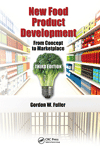Q&A with Spoonshot on 2022 snack and bakery trends
Trends include sustainability, plant-based snacks, and even snacks developed in response to a loss of smell or taste resulting from COVID-19.


courtesy of: Spoonshot

courtesy of: Spoonshot

courtesy of: Spoonshot




Snack Food & Wholesale Bakery was recently able to talk to Sayantan Paul, senior food scientist, Spoonshot, on what the new trends will be in 2022, as well as any new trends resulting from loss of smell or taste due to COVID-19.
Liz Parker: What are some snacking and bakery trends to look out for in 2022?
Sayantan Paul: [Some trends to look out for are] plant-based, health, sustainability, and hybrid products.
LP: Why are these trends important in the current world state?
SP: Plant-Based: By analyzing the occurrence of topics in articles and blogs, the main drivers of plant-based were identified as health, sustainability, and animal welfare. People have associated plant-based with health for a long time. Sustainability in the context of plant-based has grown at twice the rate (37.5 percent) of plant-based & health (15.8 percent) in the last 12 months, making sustainability an important topic to consider.
Sustainability: Companies are realizing that sustainability is no longer a nice-to-have feature but a must-have. The impacts of global warming and climate change have triggered this. According to Spoonshot, interest in sustainability has increased by 23 percent in the last year.
Hybrid Products: Using the power of two products in one-like cruffins, croffles, baissants, etc. Consumers are constantly searching for novelty and hybrid options are a safe bet for bakery companies.
Interest in hybrid bakery items grew by 177 percent in the last year according to Spoonshot.
LP: Any opportunities to those catering from loss of smell and taste, post-COVID?
SP: Consumer interest around the loss of smell is predicted to rise in the next 12 months after a small dip, while business interest around the issue remains high.
Incorporating ingredients and flavors into products/dishes that target people with anosmia and parosmia could prove to be a big winner for brands and restaurants.
Modifications of texture and flavor by use of spices, etc. which can provide an entirely new eating experience to persons suffering from loss of smell/taste could be on the rise.
The focus is on 5 elements—aroma, umami, texture, layering, and trigeminal food sensations (tingling, burning, and cooling sensations perceived from spices) to help patients recover their sense of taste and smell. Apart from this, fortifying products or dishes with Vitamin A is likely to increase as it is used as a treatment option.
As the pandemic worsened, the share of people who did not get back their sense of taste or smell completely considerably increased. A functioning of taste and smell is essential as it helps people meet their nutritional needs and prevent excessive weight loss.
LP: Any restaurant trends going on or upcoming, such as the use of robots?
SP: As the pandemic pushed the world back to their homes, the use of robots in food delivery and restaurants gained prominence. According to Spoonshot, the use of robots in food-service grew by 258 percent in the last year. This August [2-2021], Kiwibot, a robotic last-mile delivery company, announced its partnership with Sodexo, to assist in food delivery in 3 university campuses across the USA.
The labor shortage is also a key area that is being dealt with by the use of robots. Robots also find usage in back-of-house positions like assisting in the kitchen apart from the more common front office roles. Restaurants have started to use robotic solutions in filling the gaps from food making to delivery.
Hyper-Robotics (previously called Highpper), an Israel-based maker of fully autonomous robotic restaurants, launched its first fully automated restaurant concept in November, a containerized robot pizza restaurant that can pump out up to 50 pies per hour.
LP: Do you see potential and growth for lab-grown foods?
SP: Interest in lab-grown foods has grown by 60 percent over the last year, according to Spoonshot. Singapore became the first country to allow the sale of lab-grown and cell-based meat. U.S.-based Eat Just launched its lab-based meat in a local restaurant.
USDA has pumped in $10M to establish a cultivated protein center of excellence in Tuft University. In late December, Future Meat Technologies, (Future Meat), the first industry-leading company developing innovative technology to produce cultivated meat, announced that it has raised a $347M Series B round of financing.
Lab-grown food has started with meat, but the industry is certainly not going to limit itself to just that. Microbial fermentation has made it possible to experiment in cultivating all foods in the lab.
With increased focus and interest in sustainability, climate change, animal welfare, and lab-grown foods will find greater prominence.
Looking for a reprint of this article?
From high-res PDFs to custom plaques, order your copy today!






.jpg?height=200&t=1637184850&width=200)






